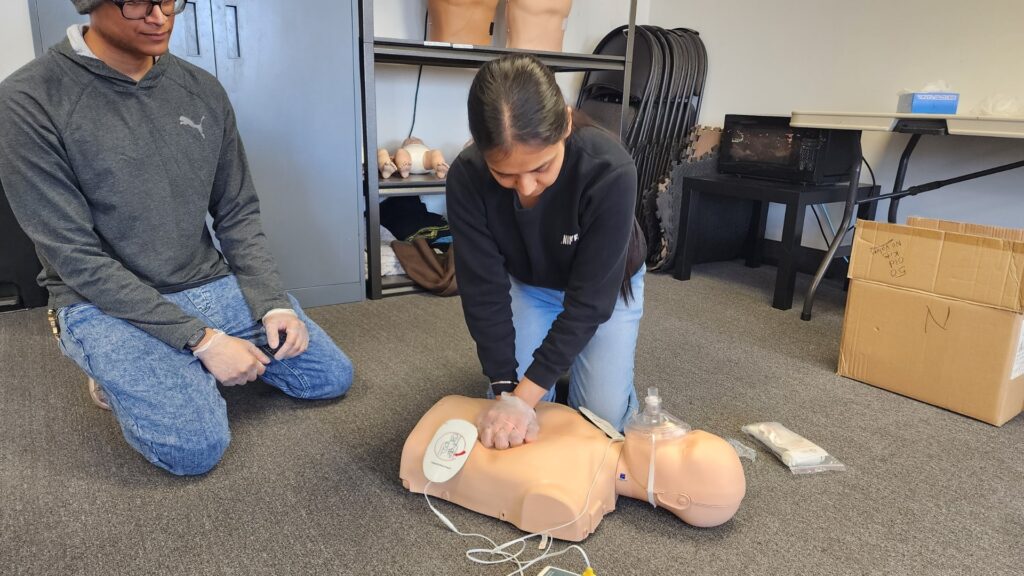Life-threatening emergencies can happen at any time, and it’s crucial to know how to respond quickly and effectively. If you’re not trained in emergency response, terms like “BLS” and “CPR” might sound confusing and even interchangeable. However, understanding the difference between these two life-saving certifications will help you be prepared and meet workplace requirements. In this blog, we’ll break down the difference between BLS and CPR, explore when you may need to use them, and provide some tips for finding the right training to become a certified responder. Whether you’re a concerned parent, a healthcare professional, or simply looking to be prepared for emergencies, this guide will equip you with the knowledge you need to save lives.
What is CPR?
CPR (cardiopulmonary resuscitation) is the emergency lifesaving procedure performed on someone whose heart has stopped beating and is unresponsive. Keeping up-to-date with CPR techniques allows you to offer the best possible help to a person in an emergency, increasing their chance of survival.
The latest CPR techniques focus on keeping the blood moving through the body, supplying the vital organs with oxygen until emergency rescue services arrive. You learn to use compressions and breathing techniques effectively to prevent the person from suffering permanent brain damage from a lack of oxygen. You also learn to perform defibrillation with an automated external defibrillator (AED). Brain damage occurs within a few minutes, so your certification can help you take the correct action to prevent this.
During a CPR course, you learn to follow the correct procedure if you witness a cardiac arrest. Therefore, you learn to assess the situation quickly, call 911, and start CPR as soon as possible.

Situations Requiring CPR
Cardiac arrests are the most common cause of the cessation of breathing in adults, and they need immediate CPR.
CPR may also be effective in other life-threatening events, including drowning, choking, and drug overdoses if the victim is not breathing and is unresponsive.
CPR is easy to learn and effective when dealing with cardiac or respiratory emergencies. Once you learn CPR, you are equipped with the knowledge and confidence to save the life of a colleague, family member, friend, or someone in your community. Remember, we don’t always administer CPR often. Therefore, keeping your CPR training and certification up-to-date allows you to stay prepared since you get the required practice and learn new techniques.
Inquire about CPR Training
Do you have questions regarding CPR training? Contact us today! Our customer service representatives are ready to assist you.
CPR in Children and Infants
Children and infants may also require CPR, especially in respiratory failure or poisoning cases. However, the protocol for CPR on children changes because they are more fragile than adults. Therefore, when you take Level C CPR, you learn the correct sequences for adults, children, and infants. For example, how to do chest compressions using your fingers instead of your palm.
What is BLS?
BLS (Basic Life Support) certification requires an intensive training course for safety professionals, first responders,healthcare providers, paramedics, sports medics, dentists, etc. You learn to function in a team of high-performance professionals effectively.
During Basic Life Support training, the topics covered include Cardiopulmonary Resuscitation (CPR), Automatic External Defibrillator (AED), Trauma, Opioid Overdose and Anaphylaxis. You may also be interested in additional training called Airway Management and Oxygen Therapy.
BLS training prepares you to care for someone with a life-threatening illness or injury until they get to a hospital. The main components of BLS include initial assessment, airway maintenance, breathing, and CPR.

Why You Should Take BLS
With BLS certification, you get high-quality CPR training that allows you to deal with adult, child, and infant emergencies effectively. In addition, during the BLS certification class, you can expect a deeper coverage of CPR fundamentals and a greater depth of basic medical knowledge, allowing a better understanding of dealing with medical emergencies.
During BLS training, you learn the four steps required to resuscitate someone who has collapsed. These are:
- Recognizing the type of emergency and taking the appropriate steps to call emergency medical services
- CPR administration as early as possible, ensuring the prevention of treatment delays until the arrival of emergency medical services
- Using a defibrillator, if needed, to help restore a person’s regular heartbeat
- Be prepared to offer advanced life support with the help of medical professionals once they arrive
Differences Between BLS and CPR
The difference between a BLS and a CPR qualification is the subject matter taught during training. BLS certification is more intensive and complex than CPR training, typically taken by healthcare professionals. These include keeping an open airway and ensuring the blood and oxygen keep circulating through the body of an unconscious person.
CPR courses are the forerunner to a BLS certification course. This course is taken by people outside of healthcare as it is more general. For example, some treatments and actions required to help someone in a medical emergency are the same in both courses.
Most healthcare workers require BLS certification, whereas the knowledge acquired in CPR is more general and suitable for everyone. But, of course, that does not mean you have to be a healthcare professional to get BLS certification.

Therefore, in a BLS course, you learn everything you need to perform life-saving CPR, including chest compressions. In addition, with BLS, you learn more in-depth practices applied in hospital settings. For example, administering oxygen, approaching CPR as a team, and advanced airway management.
CPR training is ideal for individuals and professionals such as teachers, sports coaches, and daycare workers who may have to provide lifesaving in an emergency. It is also sufficient for people requiring training for their work because they learn how to perform CPR in their work environments.
Choosing the Right Course for You
Whether you need CPR or BLS training depends on your professional capacity, workplace requirements, or personal interests.
At Coast2Coast, you have several options when you need certification for either of these courses. Be sure to confirm the course you need with your employer or school counselor before registering.
BLS Certification
BLS certification is a 4-hour all-in-class course at several locations in Greater Toronto, Western and Eastern Ontario. BLS is the ideal course if you are a student or want to make a career change to pursue a career in the healthcare industry.
The content of the course and the techniques you learn include some of those used by trained professionals like paramedics and other medically trained professionals.
These include:
- Airway Obstruction
- Assisted Ventilation
- Trauma
- Hypothermia
- Opioid Overdose
- Anaphylaxis
- High-Performance CPR for Adults, Children, and Infants
- Post-Cardiac Arrest Care
- Choking in Adults, Children, and Infants
- High-Performance Team Communication
- Post-Event Debrief

CPR Certification
CPR Certification Level A or Level C is the precursor course to BLS. At Coast2Coast, you can do the online blended or all-in-class course for both levels. Remember that you need level C if you work in an environment with infants or toddlers. Expect 5 hours of teaching time in Level A and 6 hours in Level C for the all-in-class course. The online blended courses start with online training followed by 3 hours and 4 hours, respectively, of in-class practical training.
The course includes:
- CPR/AED-Adult
- Compress-Only CPR
- Life-threatening External Bleeding
- Life-threatening Internal Bleeding
- Choking-Child and Baby (Level C)
- CPR/AED-Child and Baby (Level C)



















